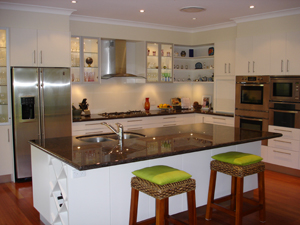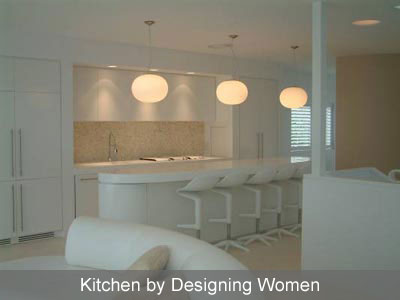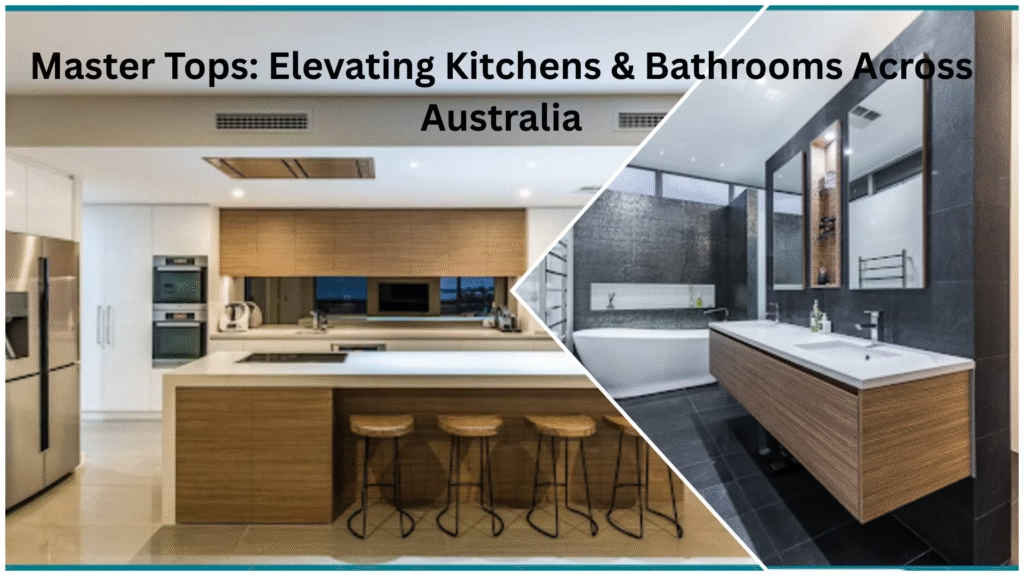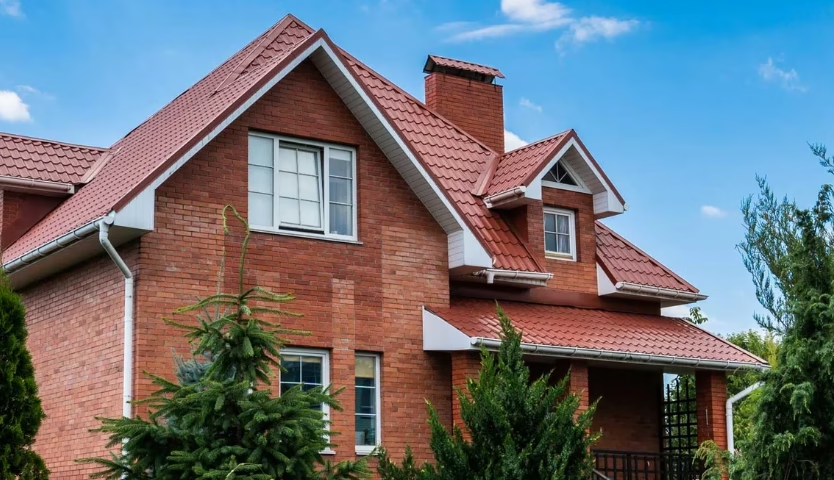How kitchen designs have changed
Once considered a utilitarian room used only for food preparation and perhaps a quick ‘bite-to-eat’, modern Australian kitchen designs has become more exposed and without doubt is now most often considered the epicenter of the house.
Thanks to the trend in open plan living spaces the modern Australian kitchen is also a meeting place, an area for friends and family to gather, not just to share a meal, but to communicate and socialise.
With its rise in status, people now expect a kitchen to be as considered and stylish as the main living area. Suppliers have responded by providing a huge increase in choice. Homeowners can now choose from a huge selection of cabinetry, fittings, lighting, and appliances.
Do you need a complete re-design?
The overall design of your new kitchen depends on how it is used and how often. Is the kitchen still just a functional food preparation space or is it also in fact an entertaining area? Are there preference activities like baking, or watching favorite TV programs, listening to music, or Internet usage while cooking?
Careful planning can make a kitchen design more spacious, improve traffic flow, and provide more storage. However changing the configuration will cost a lot more than renovating what is already there. A new kitchen design requires new plumbing, new electrics and possibly alteration to wall construction, windows and doors. If the kitchen does not benefit significantly from reconfiguration there is no point in a full renovation.
Designing the basic layout
Shape
The shape of your kitchen is often dictated by the layout of the adjoining rooms. There are however, a few general rules for the floor plan and position of the essential working components.
The most common kitchen layouts are:
- L shaped
- C shaped
- J shaped
- U shaped (the most compact and with the most cabinet space)
- Galley style
Galley style (one long bench) is the least compact but still may be a good choice for long, narrow, open plan living/ dining rooms that also house the kitchen. Breakfast bars are understandably popular and one side of most of these shapes can be used in this way. Many of the kitchen layout shapes can also work with an Island Bench that can be fixed or movable and also used a breakfast bar .
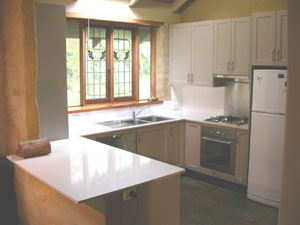
Kitchen Design Configuration
When reconfiguring, the most important consideration is the distance between the stove, the fridge and the sink. Ideally they form a triangle because a triangular layout reduces the distance between them. This is, however, not always possible. Certainly the distances between the nearest point at the bases of these three units should be no more than 8 metres.
A sink looks good when positioned in front of a window. If the stove has a featured rangehood which dominates the kitchen, then centering it along a wall looks best. If the stove has no ventilation it should be positioned near the window. The fridge may need to be placed near a door or where there is easy access.
For easy stacking from the sink place the dishwasher to the left of the sink if you are right handed, and to the right if you left handed.
Counter Area
The more you like cooking, the more a large counter area is important. Counter widths need to be 900mm to accommodate a fridge and the breathing space behind, and 600mm to accommodate the stove and most dishwashers.
Designing storage
Another consideration is the height of kitchen storage and its location for usage. Think about what you want visible and what you want to hide. Store similar items together. The most frequently used items should be close to the area where they are being used. High cupboards make good use of space but they are harder to reach. The distance between benchtop and the lower edge of cupboards should be at least 50 cm.
Finding a style

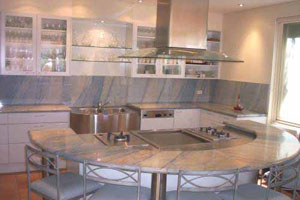
Clean, simple & elegant kitchen designs
The look you choose for kitchen must sit well alongside the style of your other living areas. It does not have to be exactly the same but there must be some connection between the two. Some styles to consider are:
- clean / white
- everyday
- welcoming
- commercial
- utilitarian
- traditional
- contemporary
As soon as you adopt a strong specific style, (which is most often reflected in the cabinetry) like French Provincial, or Rustic you are locking yourself into a very specific look. You need to be sure that you will be happy with your style choice for many years.
Selecting colours
The safest option is always simplicity and light colours. Dark colours should be used sparingly for they tend to shrink the space. Light greens, whites and creams have always been popular and workable colours. However if you are renovating in a contemporary style, there is no reason why you can’t have a strong complimentary colour as a punctuation, perhaps on a splash back.
Designing and building cabinetry
There are three basic types of cabinets.
Stock cabinets
Stock cabinets come in standard sizes, are generally timber construction with melamine cladding. Some are available in wood. They are the cheapest and can be acquired quickly; however finishes and styles are limited. They will need assembly which a competent DIY renovator could do.
Semi-custom cabinets
Semi-custom cabinets are built from a standard range but can be altered to suit the layout of your kitchen.
Custom cabinets
Custom cabinets are built precisely to your specifications by a specialist kitchen cabinet maker. A huge range of materials for benchtops and cabinet cladding is available. Cabinet makers may need a lead time of 1 – 2 weeks to acquire materials from suppliers and another week or two to build.
Cabinet materials
There is a huge variety of cabinet cladding material.
Low pressure Laminate
Laminex and Wilson-Art are low pressure laminates made from gluing an impregnated paper to particle board. They are easily cleaned and are available in a variety of colours and patterns.
High Pressure laminates
These are generally imported and are made from thicker layers of impregnated papers that are similarly glued to particle board. They come in a large variety of colours, patterns, satin, gloss and metallic finishes.
Polyurethane painted
These often have detail or layers worked into the surface.
Timber and timber veneers
Solid timber can used as a structural and/or cladding material. Solid timber is usually clear coated for natural finish but can be stained. Timber veneers create a stylish look and are easy to clean.
Vinyl film
Vacuum sealed vinyl is another new alternative.
Cabinetry fit out
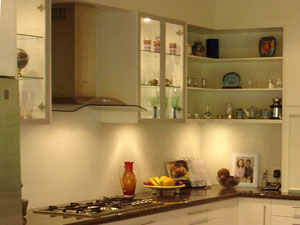
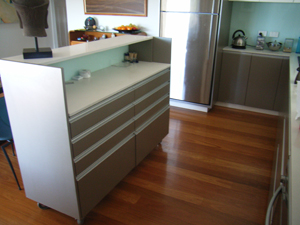
Drawers
Pull-out drawers inside cupboards are the best way to store things. It is worth spending money on good quality, easy-glide runners, especially for heavy items such as pots and food stuffs.
Cupboard width
As much as possible keep cupboard doors and drawer widths all the same. Smaller drawers look best if they are half the width of the larger but this is not always possible. Pot drawers need to be 450-600 mm wide. They are usually located at the bottom of a set of cabinets. Cutlery drawers are at the top.
A cabinet corner presents a unique problem in access which is usually solved by installing at bi-fold door. A rotating ‘lazy Susan’ in a corner cabinet can improve access.
Shelving
Consider the use of open shelving for quick access to frequently used items, a walk-in pantry, or an island bench, (possibly on lockable wheels to make it movable. )
Kitchen Designs – Selecting bench tops
Marble, granite and travertine
Premium products are
- marble
- granite,
- travertine
Polished marble comes in about a dozen varieties. It is expensive and has always been considered a luxury material. However it is porous and prone to stains, scratches, and cracking, so it needs to be sealed. It will not tolerate very hot (or cold) pots and it does not like acidic foods. Colour variation is a consideration when buying marble – it is best to check out the slab that it is cut from.
Polished granite is much more durable, and unaffected by extreme temperatures but lighter colours require sealing (but far less frequently than marble) to help prevent staining.
Travertine comes in arrange of colours from light creams and greys to gold/orange red. It is naturally pitted with holes but these can be filled in with resin or cement.
Composites
There is now an increasingly variety of manufactured composite stone and synthetic/ resin products that have an expensive natural look, are non porous, durable , and unaffected by temperature extreme. Caesar stone is reconstituted quartz composite, very sleek and tactile, but it has less resistance to extreme heat.
Laminates
Fully synthetic surfaces such as Laminex have always been popular for their hygiene, stain resistance, versatility and affordability and now come in a seamless, square edged form, and in stone-like designs.
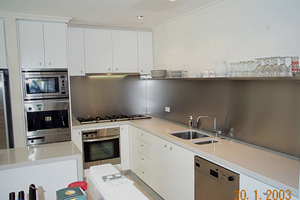
Stainless steel splashback
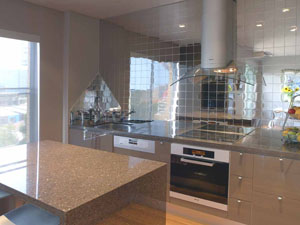
Mirror finished stainless steel tile splashback
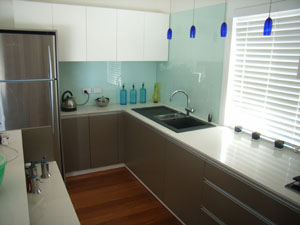
Glass splashback
Splashbacks
Splashbacks can be:
- tiled
- glass
- stainless steel
Tinted glass and stainless steel (and even stainless steel tiles) as splashbacks make a kitchen very stylish. Stainless steel is in fact a great material for kitchens. It is hygienic, stylish and beautifully reflects light – especially when there are a lot of angles. It also comes in many colours and patterns.
Kitchen Designs – Selecting Flooring
There are many choices here and your lifestyle and the overall look that you require will dictate what works best.
Synthetics
Vinyl tiles are cheap, easily cleaned (but not completely stain-proof) and while there are endless colours and designs there are only a few that are really stylish. In time they can peel off so good installation is critical.
Linoleum
Linoleum is cheap, environmentally friendly but not that durable. Forget it if you (or your partner) wears stilettos around the house.
Carpet
Carpet is very comfortable but a bore to keep clean and can therefore look quite feral after awhile. If using carpet choose a tight berber from a stain resistant material.
Timber
Natural timber looks very good, it can work with both contemporary or more traditional styles, is durable, but must be oiled or sealed because it is potentially susceptible to water damage. Timber flooring comes in various grades. The cheaper grades with more knots can look quite good in a modern, ‘beachy’ or rustic environment.
Laminates offer a stylish wood (and stone) look, are cheaper than wood, durable, easy to clean, stain resistant, but are susceptible to water damage.
Concrete
Concrete is hard on your feet, requires sealant, and ideally a tint or surface treatment of which there are many. It is the best choice for radiant heat.
Granite and Slate
Granite, and slate offer a stylish, natural look, are durable but are hard on feet. They need specialist sealants and can be slippery.
Marble
Marble is considered a luxury flooring here (though in Europe it is often used for walkways.) Polished marble is slippery, however unpolished it far less so.
Tiles
Choosing tile offers you lots of variety, but it is also hard on feet, and not stain resistant.
(Stone, tile and concrete may be too hard for young children but is the only choice if your lifestyle requires you to hose out the kitchen!)
Kitchen Designs – Selecting Appliances
You will need to allocate sufficient time to research appliances for both appearance and suitability. It is important to consult trades people on your choice before buying them to ensure that appliances are practical in the allocated space and work with the services. Like all appliances, the more expensive the appliance, the more reliable it usually is, but the more expensive the repairs. Some brands, like Miele, charge exorbitant prices for parts.
Choosing a cook top
The cook top can be integrated with the oven or come as a separate unit. They can be gas or electric or both. There are also modular burners that allow you to vary their placement.
Gas cook tops
Gas burners provide instant heat and allow precise control over temperature which is handy at the low end for simmering. BTUs (or British thermal units) measure the heating power of gas cook tops and ovens.
*Everyday cooking, 9,000 BTU should suffice. For
*Stir-frying and other high-heat cooking, you’ll need 12,000 or more.
*Simmering you need to reduce it to at least 5000 BTUs.
Electric cook tops
There are two types of electric cook tops.
Coil
Coils heat from electrical resistance inside tubes and the radiant heat is passed onto the utensil through radiation and conduction. Coils have no odour and are easier to repair. But while they are cheaper to buy they are more expensive to run. They also do not provide the precision control that is possible with gas.
Ceramic
The flat, glass ceramic cook tops uses coils or ribbons imbedded in the surface and heat with radiant, halogen or magnetic induction. The heating area is integrated into the cook top surface and is indicated with a pattern. They are easy cleaned and provide a sleek, uncluttered look. However it’s often hard to tell if the burners are off and the surface is hot or not. Magnetic induction does not work with aluminum but is the most precise for temperature control.
Kitchen Designs – Choosing an oven
Ovens can be gas or electric, however electricity is the most common due to its ability to produce deep penetrating heat.
Types of electric ovens
Electric ovens can heat conventionally by radiation from the ovens sides, by fan driven air convection, microwave (or a combination of these three) and by steam.
Most ovens are now both conventional and convection – the latter being the most popular, being faster and more efficient at heating throughout the oven.
Microwave ovens
While most microwave ovens are separate units, they can be combined into conventional ovens. They are the fastest of all oven types and are great for defrosting or quick heating. While a microwave does not brown food a combination convection/microwave will.
Specialty ovens
Specialty ovens like ‘steam ovens’, ‘pizza ovens’ and ‘warming drawers’ are also available.
Choosing a range
A range combines an oven and a cook top and can often use the same heat sources or a combination of gas and/or electric for stove top, and electric for oven. This appliance can be useful when a freestanding oven and cook top is required to sit between cabinetry and often come with a bottom storage drawer.
Kitchen Designs – Choosing a rangehood for ventilation
There are two types of ventilation systems,
- Updraft that uses a rangehood
- Down draft that sucks the air out beside or behind the stove
The down draft is more subtle but doesn’t pull out steam or odours that are some distance from the opening. They are often used with indoor grills.
Updraft rangehoods
Within the updraft system, there are two types of odour removal:
- Exhaust: pulls the polluted air outside via its internal fan and ducting.
- Recirculating: uses a fan and filter system that pulls the polluted air into filters and re-circulates cleaned air back into the kitchen.
Recirculation is nowhere near as effective an external exhaust which is essential for meat frying (which produces a lot of fat and odour).
Materials and shapes
Rangehoods most often come in brushed/stainless steel and glass (or a combination of both.) There are many different sculptural shapes to suit your chosen style – flat and integrated, suspended flat or suspended conical/ triangular, wall mounted or island.
Fans and lighting
The hood units house the multiple speed fan and cook top lighting. Make sure you test the noise of the fans before purchasing. Some use a filterless system, others have auto cleaning filters.
Choosing a dishwasher
Dishwashers have changed dramatically over the years and are now more efficient, sleeker, more compact and quieter because of better placement of motors and better insulation.
Material
Stainless steel is the most popular but dishwashers can also be integrated into the cabinetry. Some have sleek and sexy electronic touch pads. The internal surface of the washer can be plastic or stainless steel – the latter does not stain, is unaffected by hard water, is slightly more durable, looks better and is environmentally a better choice. (Plastic never breaks down – it only gets smaller and much of it ends up in the ocean.)
Size and capacity
The modern dishwasher comes in a variety of sizes and styles. The most common is the 60 x 86 x 60 mm size that can accommodate a 10-12 person dinner set. It is housed under the counter (i.e. built into the cabinetry). This size provides the most options and features – however smaller dishwashers are worth considering when space is tight.
Internal fit out
A dishwasher’s ‘stacks and racks’, adjustability and ease-of-removal are an important consideration. Dishwashers need to be able to take odd shaped items like pesky long stemmed champagne glasses. Cutlery usually sits in compartmentalised baskets but some have a tray where each item has its own little place.
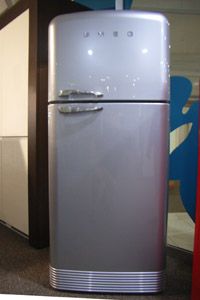
Stainless steel retro fridge
Kitchen Designs – Choosing a fridge
Materials
Fridges and their doors now come in a variety of cool materials; stainless steel, brushed steel and coloured vinyl. They can also be integrated into the cabinetry. For the hip and happy there are even retro looking fridges with rounded corners.
Configurations
There are three basic fridge configurations:
- Bottom freezer with top refrigerator
- Top freezer with bottom refrigerator
- Side-by-side freezer and refrigerator
Each has its own advantage. The bottom-freezer unit allows easier access to the refrigerator. The top-freezer model is the least expensive and tends to be the most spacious. (The top freezer configuration is usually the only one that provides a built-in ice-and-water dispenser.) The side-by-side provides easier access to both (rather narrow) compartments but is not as energy efficient.
Shelving
The configuration of shelving and size of storage areas inside is really a matter of personal preference. Shelves certainly need to be adjustable and easily removed for cleaning. Drawers are also handy in freezers. For wine drinkers you might want a wine chiller and shelving that can take those inconvenient tall, thin necked wine bottles which are higher than normal bottles and end up laying on their side. Other consideration may be a child lock or beeper that goes off when the door is left open too long, a warning to advise when to change a water filter, separate temperature controls for different compartments, and separate compressors for fridge and freezer.
Efficiency
With global warming a big issue, the energy rating of the fridge is now a major consideration and should greatly influence your choice. Check also the humidity rating.
Kitchen Designs – Selecting sinks and taps
Sinks are defined by the way they related to the benchtop, the material from which they are made, and the configuration or number of sinks.
Attachment
Sinks can attach to the benchtop in 3 ways:
- Self rimming – edges sit above the bench top
- Under mounted – attach below the countertop
- Integral – made out of the same material as the countertop
The self rimming is the most common and least expensive. Under-mounted and integral have the advantage of having a streamlined, edgeless finish where the benchtop is easily wiped clean.
Material
Stainless steel is the most popular, versatile and the durable material. It has the commercial look of a serious kitchen. It is durable, it will not chip, and is easy to clean. Scratches are almost invisible but in time it will develop its own patina or surface sheen. If necessary it can be molded to blend in with a stainless steel benchtop. Sinks are made in 18-20 gauge steel. (The lower the number the heavier and more durable is the steel).
If you want a coloured sink then choose an enameled cast iron sink. However this type of sink will chip and stain more readily than steel. Integrated sinks are molded from the same material as the benchtop and are usually a composite stone and synthetic.
Configuration
Common sink configurations are
- Single
- Double bowled
- Single and prep sink (small sink used for liquid disposal)
The deeper the sink the better. Some sinks come with their own accessories such as dish racks, colanders and movable cutting boards.
Tapware
There is a huge array of taps available. Styles vary according to taste, budget and function. The all-in-one, single tap appeals to many for its easy use and streamlined appearance. Make sure that the placement of a tap is not directly over the sink waste hole; otherwise the water will never swirl around the basin and will drive you nuts! If the base of the basin is flat, ensure that it slopes a little towards the drain hole so that water will readily drain out. If not that will also drive you nuts! And avoid gold taps – like white leather shoes, they have cheap and nasty.
Water efficiency
See www.waterrating.gov.au for details.
Designing a kitchen can be a highly satisfying and rewarding experience. There is often no best aesthetic choice – like the best shape for a tap, or the best colour for walls. More than one shape or selection of colours might work. Aesthetic decisions are subjective and for that reason not everyone will agree with you. But that is part of designing your kitchen. The decisions you make are a reflection of you and your personal taste.



